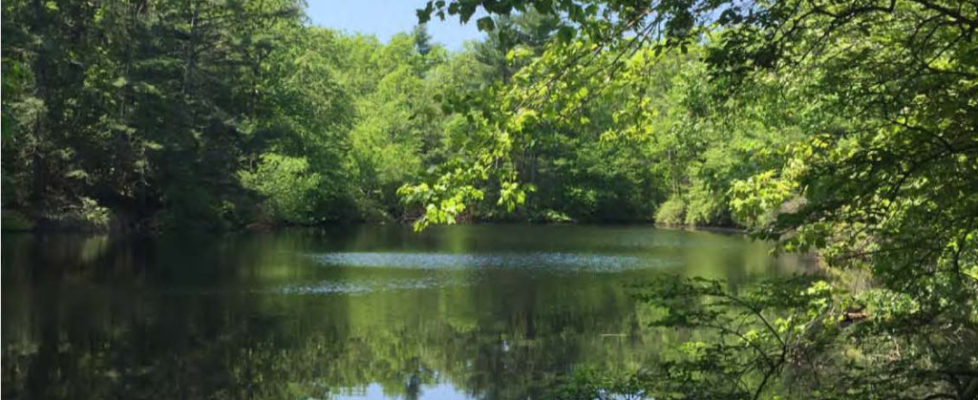Ruth Platner: Don’t Wait For A Developer’s Application To Try To Save A Special Piece Of Land
I’ve been elected to the Planning Commission since 1998, and I watched the Commission for ten years before that. In all that time, not a single person who was a neighbor of a large residential subdivision spoke in favor of the proposed development, and most asked that it not be approved. If residents were getting what they wanted, land would not be developed, but approvals of residential development have far more to do with state law and property rights than residents’ desires.
My story can illustrate what can be done, however. In 1983 my husband and I bought a piece of land in Charlestown that bordered the Pawcatuck River and the Great Swamp Management Area. We built a house there. The southern border of our land abutted a large (60-acre) parcel of private land that contained a high-tension power line and was being used by people in the Biscuit City area to access the river and the Great Swamp Management Area.
We contacted the owner of the 60-acre parcel and gained permission to cross their land to get to the state’s Management Area. In the following years, we grew to love this land that contained mature pine forests, hawks, owls, and many osprey nests.
In 1985 a survey crew asked our permission to access the 60 acres of undeveloped land through our land. Having the survey crew in our yard was fine, but a survey crew meant that the owner was planning to sell. Watching that land get developed was going to break our hearts.
At that time, there was no land trust in Charlestown and the closest Nature Conservancy office was in Boston. We knew, however, that expansion of the Great Swamp Management Area was a high priority for the Department of Environmental Management (DEM), but we also knew DEM had little money for land acquisition.
Nonetheless, we set up a meeting with DEM to find out how we could help to preserve the land. We offered to pay for part of the purchase, to buy part of the land, to buy all the land and then sell it to the state, to try and get the Nature Conservancy to buy it, to write a grant, and lots of combinations of all of these. Then we talked to the owner, who was willing to sell his land for conservation. There was lots of enthusiasm on all sides, but in 1985, neither we nor DEM had the money to buy the property, and the Nature Conservancy was not yet active in Southern Rhode Island.
Several times between 1985 and 1998 the purchase and preservation of the land almost happened, but each time it fell through because of lack of funding.
By 1998 we determined that we could afford to pay for a substantial part of the purchase, so we made a formal proposal to the state. The proposal was that, when the state purchased the entire parcel, we would buy the six acres that abutted our property from the state and then immediately donate a conservation easement on it to the state. This meant that we would own the land along our property’s border, but we would not be able to put any buildings or other developments there. This would reduce the state’s cost without reducing the total acreage in conservation.
In 1999, we paid 20% of the total land sale cost to purchase just 6 acres, and the State paid 80% of the total cost for the remaining 54 acres.
The purchase did not represent a financial gain for us, but it was a tremendous emotional gain. What was important to us was that the entire property had been put into conservation and that we had had a part in that. We considered our purchase to be mostly a donation, a donation that made us very happy.
Why is this important? Whenever there’s a public hearing on a subdivision the Town Hall chamber is filled with neighbors who oppose the development. But by the time a developer owns a parcel and has a plan before the Planning Commission, it’s probably too late to preserve the land. If the developer has followed the town’s zoning and subdivision regulations, the project has to be approved. The abutters may be able to supply information the developer has omitted, they may be able to change the layout a little, but that’s about all anyone can do.
Residents should realize that all land that is not protected as parklands or with conservation easements will be developed eventually because state law gives landowners the right to develop their land. The time to get involved in land preservation is before a developer purchases the property.
People are not powerless. If there’s a piece of land people hope won’t get developed, they should get in touch with the landowner, with DEM, with the Nature Conservancy, or with the Charlestown Land Trust. If the landowner is thinking of selling, they should talk to their neighbors. Buying the land in partnership with conservation organizations is easier and much more successful than trying to fight a subdivision. Even if they can’t afford to pay for part of the purchase, it is important to bring undeveloped parcels to the attention of conservation organizations as these organizations depend on local people to contact landowners.
Large landowners can often earn as much money selling for conservation as they can selling to a developer. Because the federal tax laws are structured to reward this kind of sale, a seller can sometimes even earn more selling their land for conservation.
An abutter must assess how much happiness they derive from a piece of land, how much it’s worth to them, and how much they can afford and act. If everyone who cared about land and wildlife habitat had the money to put where their hearts are or took other action, we could save a lot of land.

You can learn more about the author, Ruth Platner, a candidate for Charlestown Town Council, on her profile page.

September 6, 2024 @ 6:54 pm
Talk about “walking the talk!” Ruth has shown great leadership and provided us with practical way to protect valuable land for future generations.
September 6, 2024 @ 5:57 pm
ruth, thank you so much for this article we should all be eyes wide open on this to protect our valuable land
September 6, 2024 @ 1:59 pm
Thank you so much for your interesting and informative account of your experience helping to preserve that huge parcel of land.
Planet Earth thanks you, and I thank you!
September 6, 2024 @ 9:04 am
Great story Ruth….demonstrates what can be done with awareness and determination…..and by a great couple. You and Cliff are a great asset to the Town. Unfortunately it will only truly be appreciated decades from now.
Keep up the great work.
Elect Ruth to the Town council.!!!